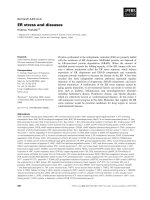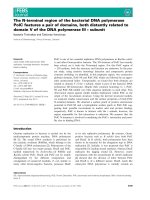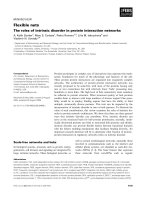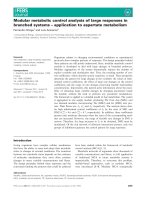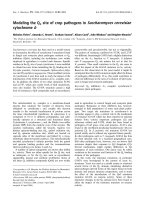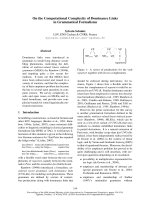Báo cáo khoa học: " Long-term outcome and quality of life of patients treated in surgical intensive care: a comparison between sepsis and trauma" doc
Bạn đang xem bản rút gọn của tài liệu. Xem và tải ngay bản đầy đủ của tài liệu tại đây (321.28 KB, 7 trang )
Open Access
Available online />Page 1 of 7
(page number not for citation purposes)
Vol 10 No 5
Research
Long-term outcome and quality of life of patients treated in
surgical intensive care: a comparison between sepsis and trauma
Helena Korošec Jagodič
1
, Klemen Jagodič
2
and Matej Podbregar
3
1
Department of Anesthesiology and Intensive Therapy, General Hospital Celje, Oblakova ulica, 3000 Celje, Slovenia
2
Department of Urology, General Hospital Celje, Oblakova ulica, 3000 Celje, Slovenia
3
Clinical Department of Intensive Internal Medicine, University Medical Centre Ljubljana, Zaloška ulica, 1000 Ljubljana, Slovenia
Corresponding author: Helena Korošec Jagodič,
Received: 31 May 2006 Revisions requested: 4 Aug 2006 Revisions received: 31 Aug 2006 Accepted: 16 Sep 2006 Published: 16 Sep 2006
Critical Care 2006, 10:R134 (doi:10.1186/cc5047)
This article is online at: />© 2006 Korošec Jagodič et al.; licensee BioMed Central Ltd
This is an open access article distributed under the terms of the Creative Commons Attribution License ( />),
which permits unrestricted use, distribution, and reproduction in any medium, provided the original work is properly cited.
Abstract
Introduction Our aim was to determine long-term survival and
quality of life of patients admitted to a surgical intensive care unit
(ICU) because of sepsis or trauma.
Methods This was an observational study conducted in an 11-
bed, closed surgical ICU at a 860-bed teaching general hospital
over a 1-year period (January 2003 to December 2003).
Patients were divided into two groups according to admission
diagnoses: group 1 included patients with sepsis; and group 2
included patients with trauma (polytrauma, multiple trauma,
head injury, or spinal injury). Quality of life was assessed after 2
years following ICU admission using the EuroQol 5D
questionnaire.
Results A total of 164 patients (98 trauma patients and 66
patients with sepsis) were included in the study. Trauma
patients were younger than patients with sepsis (53 ± 21 years
versus 64 ± 13 years; P ≤ 0.001). There was no significant
difference between groups in Acute Physiology and Chronic
Health Evaluation II score or length of stay in the surgical SICU.
Trauma patients stayed longer on the general ward (35 ± 44
days versus 17 ± 24 days; P < 001). Surgical ICU survival, in-
hospital survival, and post-hospital and cumulative 2-year
survival were lower in the sepsis group than in the trauma group
(surgical ICU survival: 60% versus 74%; in-hospital survival:
42% versus 62%; post-hospital survival: 78% versus 92%;
cumulative 2-year survival: 33% versus 57%; P < 0.05). There
was no significant difference in quality of life in all five
dimensions of the EuroQol 5D between groups: 60% of
patients had signs of depression, almost 60% had problems in
usual activities and 56% had pain.
Conclusion Patients with sepsis treated in a surgical ICU have
higher short-term and long-term mortality than do trauma
patients. However, quality of life is reduced to the same level in
both groups.
Introduction
Intensive care units (ICUs) serve patients with acute physio-
logical derangement and organ failure but who have potentially
reversible disease. They also provide a service for those who
can benefit from more comprehensive observation and com-
plex treatment than is available on standard hospital wards [1-
3].
Critical illness is associated with a wide array of serious and
troublesome long-term sequelae that may interfere with
achieving optimal patient-centred outcomes. Although tradi-
tional short-term outcomes, such as hospital mortality, remain
extremely important, they are unlikely to be adequate surro-
gates for subsequent patient-centred outcomes. As such, it is
important to focus specifically on how critical illness and inten-
sive care can affect long-term health and well being [4].
Critical care patients differ with respect to the reason for their
admission to the ICU, and these differences are likely to result
in different expectations regarding their health. Therefore,
when measuring outcomes in intensive care patients, we
should take into account the possibility that outcomes will vary
by admission diagnostic category [5]. The aim of the present
study was to compare the long-term survival and quality of life
of patients treated in a surgical ICU because of sepsis or
trauma.
APACHE = Acute Physiologic and Chronic Health Evaluation; ARDS = adult respiratory distress syndrome; HR-QOL = health-related quality of life;
ICU = intensive care unit; LOS = length of stay.
Critical Care Vol 10 No 5 Korošec Jagodič et al.
Page 2 of 7
(page number not for citation purposes)
Materials and methods
In an observational study we included patients admitted to the
surgical ICU over a 1-year period (January 2003 to December
2003). The surgical ICU at our 860-bed teaching general hos-
pital is an adult, 11-bed, closed unit. Permission to perform the
study was granted by the national ethics committee.
Patients were divided into two groups according to admission
diagnoses: group 1 included patients with sepsis (severe sep-
sis and septic shock) and group 2 included those with trauma
(polytrauma, multiple trauma, head injury, or spinal injury). Sep-
sis was defined as clinical signs suggesting the presence of
systemic inflammatory response syndrome together with defi-
nite evidence of infection. Systemic inflammatory response
syndrome was defined as any two of the following [6-8]: tem-
perature >38°C or <36°C; heart rate >90 beats/min; respira-
tory rate >20 breaths/min or arterial carbon dioxide tension
<32 mmHg; and white blood cell count >12,000 cells/mm
3
or
<4000 cells/mm
3
, or with >10% immature (band) forms. Sep-
sis was considered severe when it was associated with organ
dysfunction, hypoperfusion, or hypotension [7]. Septic shock
was defined as sepsis with hypotension despite adequate fluid
resuscitation, combined with perfusion abnormalities that may
include lactic acidosis, oliguria, or an acute alteration in mental
status [7]. Polytrauma was defined as injury to several physical
regions or organ systems, where at least one injury or a com-
bination of several injuries was life threatening, with the sever-
ity of injury being 16 or greater on the Injury Severity Score [9].
Multiple trauma was defined as physical insults or injuries
occurring simultaneously in several parts of the body, and it
was differentiated from polytrauma because multiple trauma
was not life threatening [9,10].
Patient demographic characteristics, length of stay (LOS) in
the surgical ICU, severity of illness (risk for hospital mortality,
as indicated by Acute Physiology and Chronic Health Evalua-
tion [APACHE] II score) and LOS in the general ward were all
recorded, as were surgical ICU and hospital outcome. When
patients were readmitted to the surgical ICU, data from their
last admission were used. The hospital patient's registry was
used to obtain information on patients who had died in the
hospital. Survival data for patients 2 years after ICU treatment
were collected from the Central Register of Inhabitants for the
Republic of Slovenia.
Quality of life was assesed after 2 years following ICU admis-
sion for surviving patients using EuroQol 5D questionnaire and
a telephone interview. EuroQoL 5D [11-13] is a generic health
status measure that consists of three parts: a descriptive sys-
tem, a visual-analogue scale, and an EuroQol 5D Index. The
descriptive system measures health in five dimensions: mobil-
ity, self-care, usual activities, pain/discomfort and anxiety/
depression. Patients mark one of three levels of severity (1 =
no problems, 2 = some/moderate problems and 3 = severe/
extreme problems) in each dimension. Combinations of these
categories define a total of 243 different health states. The
EuroQol 5D Index [14], based on the five dimensions and
ranging from -0.11 ('worse than death') to 1 ('perfect health'),
was also calculated. In the present study we used only the
descriptive system and the EuroQol 5D Index.
Patients or family members of patients who were discharged
alive were contacted by phone to determine their willingness
to participate in the study and were asked to complete the
questionnaire. In the case of severe disability of patients, we
used proxy assessment of health-related quality of life (HR-
QOL) [4,15].
Statistical analysis
The characteristics of the study population were assessed
using the two-way Student's t-test for continuous and nonpar-
ametric Mann-Whitney U-test for noncontinuous variables.
Results are presented as mean ± standard deviation (range).
The survival of patients is displayed graphically using Kaplan-
Meier curves, and any differences between curves were
explored using log-rank or Tarone-Ware tests. For correction
of age between two groups of patients (patients with sepsis
and patients with trauma), Cox survival analysis was used.
For assessing differences in baseline characteristics between
responders and nonresponders to the EuroQol 5D question-
naire, we used independent samples t-test. Analysis of vari-
ance was used to test for mean difference in EuroQol 5D
profile between patients with sepsis and patients with trauma.
P < 0.05 was considered statistically significant.
Table 1
The demographic details of the patients categorized by surgical ICU admission diagnostic category
Admission diagnostic
category
Number of patients Age (years) Male sex (n [%]) APACHE II score Days in the surgical ICU Days in the general ward
Sepsis 66 64.4 ± 13.5* 32 (49)** 15.5 ± 6.4 11.8 ± 16.1 17.3 ± 23.5***
Trauma 98 53.2 ± 21.5 70 (71) 14.3 ± 6.6 11.9 ± 12.5 35.0 ± 44.2
Data are expressed as mean ± standard deviation, unless otherwise indicated. *P < 0.001, **P = 0.006 and ***P = 0.001, versus trauma.
APACHE, Acute Physiology and Chronic Health Evaluation; ICU, intensive care unit.
Available online />Page 3 of 7
(page number not for citation purposes)
A statistical computer program (SPSS, version 13; SPSS Inc.,
Chicago, IL, USA) was employed to conduct data analysis.
Results
Between January 2003 and December 2003, a total of 164
patients were included in the study. Sixty-six of the patients
were admitted because of sepsis (severe sepsis and septic
shock), and 98 of the patients were admitted after trauma (pol-
ytrauma, multiple trauma, head injury, or spinal injury). Gas-
trointestinal surgery (complications of gastrointestinal surgery,
emergency gastrointestinal surgery and pancreatitis)
accounted for 76% of all patients in the sepsis group.
The demographic characteristics of the patients, stratified by
admission diagnosis, are shown in Table 1. The two groups of
patients differed in some respects. Trauma patients were
younger than patients with sepsis (53 ± 21 years versus 64 ±
13 years; P < 0.001). There were significantly more men in the
trauma than in the sepsis group (71% versus 49%; P =
0.006). There was no significant difference between groups in
APACHE II score or surgical ICU LOS. Trauma patients
stayed longer on the general ward (35 ± 44 days versus 17 ±
24 days; P < 0.001).
Mortality analysis was separated into short-term mortality (sur-
gical ICU and in-hospital mortality) and long-term mortality
(post-hospital mortality). Surgical ICU mortality in the sepsis
group was higher than that in the trauma group (40% versus
26%; P = 0.036; Figure 1). In-hospital mortality of patients
with sepsis was also higher than that of patients with trauma
(58% versus 38%; P = 0.002; Figure 2). Patients with sepsis
were older than trauma patients (Table 1). To evaluate the
independent effects of age and admission diagnosis (sepsis
or trauma) on mortality, we conducted a Cox survival analysis.
After controlling for age, we found that admission diagnosis
had a significant effect on in-hospital survival (hazard ratio
1.73; P = 0.02; Figure 3).
The long-term outcomes of patients with sepsis and trauma
were also significantly different. Not only did the patients with
sepsis suffer a higher surgical ICU and in-hospital mortality,
but these patients also had poorer long-term outcomes. Figure
4 illustrates the survival of patients after hospital discharge.
Post-hospital mortality of patients with sepsis was higher than
that of patients with trauma (22% versus 8%; P = 0.049; Fig-
ure 4). Finally, cumulative 2-year mortality was higher in the
sepsis group than in the trauma group (67% versus 43%; P =
0.002; Figure 5).
Of the 89 patients who were discharged from hospital, 11
(12%) died during the 2-year follow-up period. Quality of life
was assessed in 39 patients (50%) of the 78 surviving
patients 2 years after ICU admission. In all, 48% (10/21)
patients with sepsis and 51% (29/57) patients with trauma
participated in the HR-QOL assessment. In addition, baseline
characteristics of responders and nonresponders to EuroQol
5D are summarized in Table 2. There was no significant differ-
ence in age, sex, LOS in the surgical ICU and hospital
between the two groups (Table 2). Only APACHE II score was
higher in nonresponders (13.7 ± 5.9 versus 11.0 ± 4.3; P <
0.02; Table 2).
Mean (± standard deviation) EuroQol 5D Index was 0.72 ±
0.24 and did not differ between patients with sepsis and those
with trauma. One trauma patient described her functional
status as being worse than death (EuroQol 5D Index = -0.11).
Eighty-two per cent of patients reported having a problem
(moderate or extreme) in at least one dimension of EuroQol
5D. There was no significant difference in quality of life in all
five dimensions of EuroQol 5D between groups (Figure 6).
Figure 1
Surgical ICU mortalitySurgical ICU mortality. The Kaplan-Meier survival curve shows that
patients with sepsis had higher surgical ICU mortality than did patients
with trauma. ICU, intensive care unit.
Figure 2
In-hospital mortalityIn-hospital mortality. The Kaplan-Meier survival curve shows that
patients with sepsis had higher in-hospital mortality than did patients
with trauma.
Critical Care Vol 10 No 5 Korošec Jagodič et al.
Page 4 of 7
(page number not for citation purposes)
Almost 60% of patients reported having problems in usual
activities, 56% had pain and 56% had mobility problems; in
contrast, most of patients (74%) reported having no problems
in self-care. Depression and anxiety were more often detected
in trauma patients, but the difference relative to the sepsis
group was not significant (P = 0.1).
Discussion
Two main findings of the present study may be identified. First,
patients with sepsis treated in the surgical ICU have higher
short-term (surgical ICU and in-hospital) and long-term (post-
hospital) mortality than do trauma patients. Not surprisingly,
cumulative 2-year mortality was higher in the sepsis group
than in the trauma group. Severe sepsis is a life-threatening
complication of infection. Becaue of the associated organ fail-
ure, treatment in the ICU is usually necessary. Several studies
have shown that sepsis is the leading cause of mortality for
patients admitted to ICUs [16-19]. The observation that sepsis
reduces long-term survival when compared with trauma is also
consistent with observations from other studies.
Davidson and colleagues [20] compared two specific groups
of patients with adult respiratory distress syndrome (ARDS)
and demonstrated that sepsis-ARDS patients had a sixfold
higher late (post-hospital) mortality rate than did trauma-ARDS
patients.
There were some differences in baseline characteristics
between the two groups of patients in our study. Patients with
sepsis were older than the trauma patients. Sepsis is highly
correlated with age and comorbidities, and it may be difficult
to separate their independent effects on mortality [21]. David-
son and coworkers [20] also argued that critical care outcome
could only be measured in patients who were selected for
admission to the ICU, and therefore only reflected the out-
come of a subset of elderly patients. As shown in Figure 3,
even after controlling for age, sepsis as the admission diagno-
sis had a significant effect on in-hospital mortality in our study.
The second main finding of our study is that, although patients
with sepsis had higher long-term mortality and were older then
the trauma patients, there was no significant difference in qual-
ity of life after 2 years following intensive treatment. Patients
with trauma even had a tendency toward greater anxiety and
depression compared with patients who had sepsis. There-
fore, quality of life was reduced to the same level in both
Table 2
Comparison of responders with nonresponders to the EuroQol 5D questionnaire
EuroQol 5D
questionnaire
Number of
patients (%)
Admission
diagnosis
Age (years) Male sex (n [%]) APACHE II score Days in surgical ICU Days in hospital
Responders 39 (50) Trauma: 29
Sepsis: 10
45.0 ± 19.8 25 (64) 11.0 ± 4.3* 11.4 ± 14.4 40.0 ± 52.8
Nonresponders 39 (50) Trauma: 28
Sepsis: 11
52.4 ± 18.3 26 (69) 13.7 ± 5.9 10.1 ± 8.6 37.0 ± 35.4
Data are shown as mean ± standard deviation, unless otherwise indicated. APACHE, Acute Physiology and Chronic Health Evaluation; ICU,
intensive care unit. *P = 0.02 versus nonresponders.
Figure 3
In-hospital mortality, controlling for ageIn-hospital mortality, controlling for age. The Cox survival analysis
shows that patients with sepsis had higher in-hospital mortality than did
trauma patients, after controlling for age.
Figure 4
Post-hospital mortalityPost-hospital mortality. The Kaplan-Meier survival curve shows that
patients with sepsis had higher post-hospital mortality than did patients
with trauma.
Available online />Page 5 of 7
(page number not for citation purposes)
groups, and 82% of patients reported a problem (moderate or
extreme) in at least one dimension of EuroQol 5D, but most
patients (74%) reported no problems in self-care.
Critical care patients differ with respect to the cause of their
admission to the ICU. We may presume that most patients
with trauma were previously healthy individuals who suffered a
severe injury and were admitted to the surgical ICU as a result
of acute, life-threatening insults. Badia and coworkers [15]
reported that trauma patients experienced considerable wors-
ening in their quality of life, because the price of their survival
was a deterioration in their HR-QOL as a result of the injuries
sustained. On the other hand, patients with sepsis are usually
more chronically ill and consequently have diminished HR-
QOL, and are admitted to the surgical ICU because of exacer-
bation of pre-existing chronic pathologies or for surgical inter-
ventions aimed at improving their HR-QOL. We must
emphasize that our study was conducted in a surgical ICU,
and the patients with sepsis (76%) were mostly admitted after
major abdominal surgery and had abdominal sepsis. Harald-
sen and Andersson [22] retrospectively evaluated long-term
outcomes in patients treated in a surgical ICU for abdominal
sepsis. They reported that most patients who had survived
after treatment of abdominal sepsis in the surgical ICU
regained good health and restored functional status.
Granja and coworkers [23] also compared the HR-QOL of
survivors from severe sepsis and septic shock with HR-QOL
in others who had survived critical illness not involving sepsis
using EuroQol 5D. They reported that survivors from severe
sepsis and septic shock had similar HR-QOL to that of survi-
vors from critical illness admitted without sepsis. In contrast to
those studies, Davidson and colleagues [24] compared HR-
QOL in ARDS survivors who had sepsis as their primary risk
factor for ARDS with HR-QOL in ARDS survivors with trauma
as their primary risk factor for ARDS. They concluded that
sepsis-ARDS patients had worse HR-QOL than did trauma-
ARDS patients.
The present study has limitations. No patients were lost to fol-
low up for the assessment of survival, but 50% were lost to fol-
low up for the assessment of quality of life at 2 years. Why did
we lose so many patients? In our assessment of quality of life
we used telephone interview, and for the most part those
patients who were lost to follow up had no telephone or had
changed their telephone number so we could not contact
them. In addition, patients or relatives who refused to cooper-
ate in the study were also lost to follow up. We believe that
although we lost so many patients, our population of patients
who underwent HR-QOL assessment was representative; in
our comparison of responders with nonresponders to the
EuroQol 5D questionnaire, we identified no differences in
baseline demographics (age or sex) or in surgical ICU or hos-
pital LOS between the two groups of patients.
A further potential limitation of this study was its inability to
assess baseline HR-QOL of patients before surgical ICU
admission. We assessed quality of life in surviving patients 2
years after ICU admission; this is quite a long period, and rec-
ollection of baseline HR-QOL before surgical ICU admission
after such an interval may not be accurate. Grady [25] sug-
gested that researchers should be cautious, emphasizing that
recall of status at an earlier time point could be influenced by
the current situation.
Figure 5
Cumulative 2-year mortalityCumulative 2-year mortality. The Kaplan-Meier survival curve shows that
patients with sepsis had higher cumulative 2-year mortality than did
patients with trauma.
Figure 6
EuroQol 5D profile after 2 yearsEuroQol 5D profile after 2 years. The EuroQol 5D profile is dichot-
omized into 'no problems' and 'moderate/extreme problems'. After 2
years there was no significant difference between the sepsis group and
the trauma group.
Critical Care Vol 10 No 5 Korošec Jagodič et al.
Page 6 of 7
(page number not for citation purposes)
EuroQol 5D was the instrument of choice because it is a sim-
ple and short questionnaire that is easily understood and
answered by the patients. It is a generic HR-QOL instrument
that, apart from permitting estimation of an overall quality of life
index, specifically measures a range of physical and nonphys-
ical dimensions [5,11-13]. Its usefulness and construct validity
have been tested in patients in several studies [15,26-32]. In
addition, it is an appropriate method for measuring HR-QOL in
critically ill patients [4]. Telephone assessment of EuroQol 5D
has the advantage of avoiding the need to recall patients to the
hospital; telephone assessment of EuroQol 5D was also vali-
dated in several studies [4,30,31]. Badia and coworkers [15]
also reported that proxy responses could be reliably used with
the EuroQol 5D when measuring change in HR-QOL.
Conclusion
In summary, two main conclusions may be drawn from the
study. Patients with sepsis treated in the surgical ICU have
higher in-hospital and post-hospital mortality than do trauma
patients, but quality of life is reduced to the same level in both
groups. This means that survival and quality of life after critical
illness are independent; when evaluating outcome after inten-
sive care, it is necessary to incorporate assessments of both
quality of life and survival.
Competing interests
The authors declare that they have no competing interests.
Authors' contributions
HKJ was involved in the design of the study; in the acquisition,
analysis and interpretation of data; and drafted the manuscript.
KJ helped to draft the manuscript. MP participated in the
design of the study, helped to perform statistical analysis and
revised the manuscript critically. All authors read and
approved the final manuscript.
Acknowledgements
We should like to acknowledge the staff and patients of the surgical ICU
in the General Hospital Celje for their help and support with this study.
There were no special sources of funding for the study.
References
1. Chang SY, Multz AS, Hall JB: Critical care organization. Crit
Care Clin 2005, 21:43-53.
2. Ferdinande P: Recommendations on minimal requirements for
intensive care departments. Intensive Care Med 1997,
23:226-232.
3. Fisher M: Critical care-the worldwide perspective. Ann Acad
Med Singapore 1998, 27:376-380.
4. Angus DC, Carlet J, on behalf of the 2002 Brussels Roundtable
Participants: Surviving Intensive Care: a report from the 2002
Brussels Roundtable. Intensive Care Med 2003, 29:368-377.
5. Needham DM, Dowdy DW, Mendez-Tellez PA, Herridge MS, Pro-
novost PJ: Studying outcomes of intensive care unit survivors:
measuring exposures and outcomes. Intensive Care Med
2005, 31:1153-1160.
6. American College of Chest Physicians/Society of Critical Care
Medicine: Consensus Conference: definitions for sepsis and
organ failure and guidelines for the use of innovative thera-
pies in sepsis. Crit Care Med 1992, 20:864-874.
7. Balk RA: Severe sepsis and septic shock. Definitions, epidemi-
ology, and clinical manifestations. Crit Care Clin 2000,
16:179-192.
8. Levy MM, Fink MP, Marshall JC, Abraham E, Angus D, Cook D,
Cohen J, Opal SM, Vincent JL, Ramsay G, SCCM/ESICM/ACCP/
ATS/SIS: 2001 SCCM/ESICM/ACCP/ATS/SIS International
Sepsis Definitions Conference. Crit Care Med 2003,
31:1250-1256.
9. Recommended Guidelines for Diagnostics and Therapy in
Trauma Surgery [ />019e.htm]
10. Multiple trauma (Biology-Online.org) [logy-
online.org/dictionary/Multiple_Trauma]
11. The EuroQol Group: EuroQol: a new facility for the measure-
ment of health-related quality of life. Health Policy 1990,
16:199-208.
12. Rabin R, de Charro F: EQ-5D: a measure of health status from
the EuroQol Group. Ann Med 2001, 33:337-343.
13. EQ-5D: an instrument to describe and value health [http://
www.euroqol.org]
14. Calculating the U.S. population-based EQ-5D Index score
[ />]
15. Badia X, Diaz-Prieto A, Gorriz MT, Herdman M, Torrado H, Farrero
E, Cavanilles JM: Using the EuroQol-5D to measure changes in
quality of life 12 months after discharge from an intensive care
unit. Intensive Care Med 2001, 27:1901-1907.
16. Marshall JC, Vincent JL, Guyatt G, Angus DC, Abraham E, Bernard
G, Bombardier C, Calandra T, Jorgensen HS, Sylvester R, et al.:
Outcome measures for clinical research in sepsis: a report of
the 2nd Cambridge Colloquium of the International Sepsis
Forum. Crit Care Med 2005, 33:1708-1716.
17. Wright JC, Plenderleith L, Ridley SA: Long-term survival follow-
ing intensive care: Subgroup analysis and comparison with
the general population. Anaesthesia 2003, 58:637-642.
18. Vincent JL, Sakr Y, Sprung CL, Ranieri VM, Reinhart K, Gerlach H,
Moreno R, Carlet J, Le Gall JR, Payen D, Sepsis Occurrence in
Acutely Ill Patients investigatiors: Sepsis in European intensive
care units: results of the SOAP study. Crit Care Med 2006,
34:344-353.
19. Vincent JL, Abraham E: The last 100 years of sepsis. Am J
Respir Crit Care Med 2006, 173:256-263.
20. Davidson TA, Rubenfeld GD, Caldwell ES, Hudson LD, Steinberg
KP: The effect of acute respiratory distress syndrome on long-
term survival. Am J Respir Crit Care Med 1999, 160:1838-1842.
21. Martin GS, Mannino DM, Eaton S, Moss M: The epidemiology of
sepsis in the United States from 1979 through 2000. N Engl J
Med 2003, 348:1546-1554.
22. Haraldsen P, Andersson R: Quality of life, morbidity, and mortal-
ity after surgical intensive care: a follow-up study of patients
treated for abdominal sepsis in the surgical intensive care
unit. Eur J Surg Supp 2003:23-27.
23. Granja C, Dias C, Costa-Pereira A, Sarmento A: Quality of life of
survivors from severe sepsis and septic shock may be similar
to that of others who survive critical illness. Critical Care 2004,
8:R91-R98.
24. Davidson TA, Caldwell ES, Curtis JR, Hudson LD, Steinberg KP:
Reduced quality of life in survivors of acute respiratory dis-
Key messages
• We studied long-term outcomes in patients with the
two most frequent admission diagnoses admitted to the
surgical ICU: sepsis and trauma.
• Patients with sepsis had higher in-hospital and post-
hospital mortality than did trauma patients.
• Quality of life, as measured using the EuroQol 5D ques-
tionnaire, was reduced to the same level in both groups,
and 82% of patients reported a problem in at least one
dimension of the EuroQol 5D.
Available online />Page 7 of 7
(page number not for citation purposes)
tress syndrome compared with critically ill control patients.
JAMA 1999, 281:354-360.
25. Grady KL: Beyond morbidity and mortality: quality of life out-
comes in critical care patients. Crit Care Med 2001,
29:1844-1846.
26. Badia X, Schiaffino A, Alonso J, Herdman M: Using the EuroQol
5-D in the Catalan general population: feasibility and construct
validity. Qual Life Res 1998, 7:311-322.
27. Kind P, Dolan P, Gudex C, Williams A: Variations in population
health status: results from a United Kingdom national ques-
tionnaire survey. BMJ 1998, 316:736-741.
28. Sznajder M, Aegerter P, Launois R, Merliere Y, Guidet B, CubRea
: A cost-effectiveness analysis of stays in intensive care units.
Intensive Care Med 2001, 27:146-153.
29. Herridge MS: Long-term outcomes after clinical illness. Curr
Opin Crit Care 2002, 8:331-336.
30. Cuthbertson BH, Scott J, Strachan M, Kilonzo M, Vale L: Quality
of life before and after intensive care. Anaesthesia 2005,
60:332-339.
31. Granja C, Teixeira-Pinto A, Costa-Pereira A: Quality of life after
intensive care- evaluation with EQ-5D questionnaire. Intensive
Care Med 2002, 28:898-907.
32. Bouillon B, Kreder HJ, Eypasch E, Holbrook TL, Mayou R, Nast-
Kolb D, Pirente N, Schelling G, Tiling T, Yates D: Quality of life in
patients with multiple injuries-basic issues, assessment, and
recommendations. Restor Neurol Neurosci 2002, 20:125-134.



